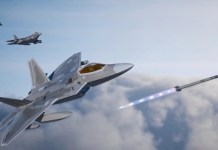The Iranian-designed Shahed-136 drones have been an important factor in the Ukraine War. Impressed with the performance of these propeller-driven, one-way, explosive-laden kamikaze drones, Russia quickly began producing these drones locally under license from Tehran.
In 2023, Iran permitted Russia to produce these drones as part of a US$1.75 billion deal. Russia introduced substantial modifications in these drones, changing the engines, warheads, and even the color of these drones. In its new Russian iteration, these drones are called Geran-2.
Russia is currently producing these drones at the Alabuga drone factory, reportedly the world’s largest drone factory, as well as at an undisclosed facility in Izhevsk.
The Shahed-136 drones have now even caught the attention of the US.
The US Air Force (USAF) has asked the industry to produce identical copies of the Shahed-136 drone to develop and test defenses against the Iranian-designed system.
According to a Request for Information (RFI) posted last week, the USAF wants to buy 16 of these Shahed-136 lookalikes, with the option to buy 20 more at a later stage, to test the ‘next-generation’ of its counter-drone systems against these threats.
“The United States Government (USG) intends to purchase approximately 16 counter Unmanned Aerial System (cUAS) drones to support the next generation of cUAS weapons program development and integration. To support weapons development and integration of these weapon systems, the USG requires that the Class 3 Unmanned Aerial Target System be a 1:1 copy (form, fit, and function) of a reverse-engineered Shahed-136 suicide drone,” the solicitation said.
The RFI mentions that adversarial countries are currently using the Shahed-136 drones.
“This acquisition aims to leverage drones representative of the Shahed-136, which is currently used by adversarial countries and is being encountered in multiple areas of
operation,” it added.
The Russian Geran-2 (Shahid) drones form the bulk of the Russian drone assaults on Ukraine.
Russia launched a record-breaking 6,129 attacks against Ukraine using Shahed drones this July, up from 5,337 attacks in June. On July 9 alone, Russia targeted Ukraine with 728 drones.
In the coming months, Moscow aims to strike Ukraine with a single salvo of 2,000 Shahed drones in a single night.
These large-scale attacks have become possible because Russia has dramatically ramped up the production of these one-way attack drones.
Earlier this month, Vadym Skibitskyi, deputy head of Ukraine’s military intelligence (HUR), said that Russia plans to produce 79,000 Shahed-type drones in 2025.
The Alabuga Special Economic Zone in Russia’s Republic of Tatarstan, approximately 1,100 km (620 miles) from the Ukrainian border, hosts a major Shahed assembly plant. Last month, Moscow released a grisly video of the drone factory, showing rows and rows of matt-black “Geran-2” drones, the Russian-built version of the Iranian-designed Shahed 136.
Inside Russia’s Geran-2 drone factory in Tatarstan
Rare footage reveals the Alabuga plant’s mass production of tens of thousands of deadly kamikaze drones
Designed to attack in relentless swarms — 'Gerans' punch through Ukraine’s defenses — outmaneuvering even F-16s pic.twitter.com/5bghxrtRPl
— RT (@RT_com) July 20, 2025
The USAF RFI says that the Iranian Shahed-136 drones are “utilized by the Russians in Ukraine,” are “difficult to detect, fly low, and descend to one hundred meters before hitting the target.”
Furthermore, the RFI says that the drone must be a replica of the Iranian drone, a 1:1 copy (reverse engineered) of the Shahed 136 suicide drone.
“It needs to meet the form, fit, and function of the Shahed 136 currently being developed and used by Iran. This is to include – Rear-facing propeller with the same size and position characteristics as the Shahed-136, Same Shape/profile, and Same payload capacity.”
However, the RFI has provided relaxation in one crucial area. The drone should be able to fly 50 miles, which is far less than the range of over a thousand miles of Shahed-136, but sufficient for testing purposes.
The Shahed Drones In The Ukraine War
Designed by Iran and mass-produced under license by Russia with substantial modifications, the Shahed-136 drones have emerged as Moscow’s weapon of choice in the Ukraine War.
The drone is not only difficult to detect, but it also enjoys a clear cost advantage. Each piece of this drone costs around US$40,000 to US$50,000; however, the air defense missiles Ukraine uses to intercept them cost millions of dollars per missile.
Notably, Russia also fires dozens of decoys with these drones to confuse and overwhelm Ukrainian air defense systems.
Russia is already producing 5,000 long-range Shahed-136 drones every month. The Yelabuga factory alone is believed to have produced over 18,000 drones in the first six months of 2025.
However, analysts warn that Russia can further scale its drone production in the coming months.
Security analysts warn that behind Russia’s dramatic increase in daily drone attacks lies a calculated strategy of breaking the morale of the Ukrainian armed forces, terrorising the civilian population, and breaking the Western support for Kyiv.

The ISW assessed that the drone attacks are meant to psychologically exhaust Ukraine and erode Western support.
Similarly, a new report by the Lowy Institute warns that with President Vladimir Putin frustrated by a stalled summer offensive, his focus has turned to breaking Western and Ukrainian morale with barrages of drone strikes at civilian targets.
According to the Center for Strategic and International Studies (CSIS), “Russia’s relentless use of low-cost drones signals a broader shift toward attrition warfare based on overwhelming air defense systems with sheer numbers. Western governments must innovate in economical defenses and tackle Chinese technology flows fueling Russian drone production.”
While effective against ballistic missiles, using multi-million-dollar Patriot interceptors to shoot down Shahed-136 drones worth only tens of thousands of dollars is economically unsustainable.
It appears that the next frontier in this technological race is the development of cheap and scalable drone interceptors, and the USAF is also trying to build these counter-UAS (cUAS) systems.
The RFI for procuring replicas of Iranian Shahed-136 drones is meant to test the USAF’s cUAS systems’ efficiency and success against these drones. However, the RFI also underlines how the cheap Iranian-designed drones have transformed the Ukraine war and caught the attention of militaries all over the world.
- Sumit Ahlawat has over a decade of experience in news media. He has worked with Press Trust of India, Times Now, Zee News, Economic Times, and Microsoft News. He holds a Master’s Degree in International Media and Modern History from the University of Sheffield, UK.
- VIEWS PERSONAL OF THE AUTHOR.
- He can be reached at ahlawat.sumit85 (at) gmail.com




